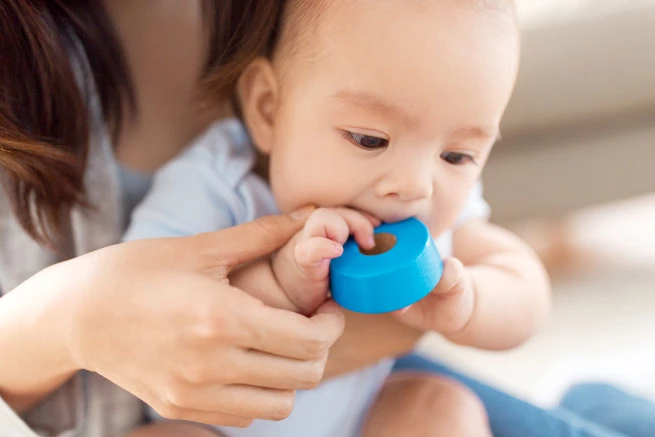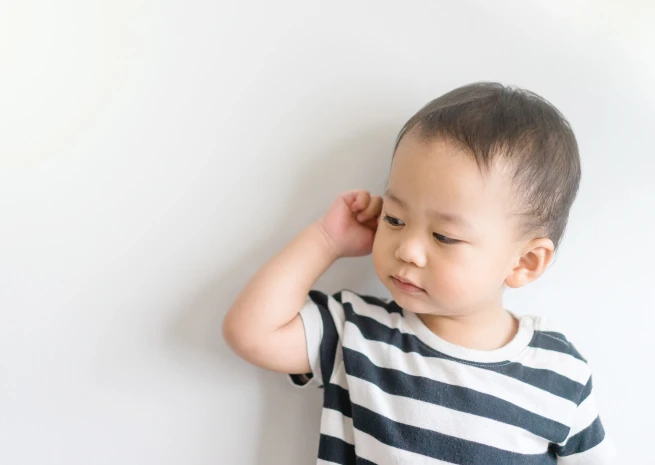When do babies start teething?
Tooth buds actually start to develop while a baby is in the womb. Signs of baby teething usually begins at around six months, but some children are born with their first teeth, and some don’t start teething until after they are one year old. Usually all of a child’s baby teeth will have emerged by the time they are 2 ½ years old.
Paediatric nurse Dawn Kelly says: “A baby’s milk teeth usually start to come through the gums around six months, although it can happen as early as four months or as late as after one year. Some babies are even born with teeth. It might be rare, but it’s perfectly normal for a baby to be born with their first tooth protruding through the gums. They are called natal teeth. Others can start teething within just four weeks – these are rarer and are called neonatal teeth.
All of your child’s milk teeth will probably emerge by the time they are around two and a half years old, but keep in mind that every baby is different.”
This content was written by healthcare professional Dawn Kelly in 2015. She was paid for her time but does not endorse CALPOL® Products.
When your baby reaches teething age, it can be a distressing time for them and parents, so it’s important you’re on hand with lots of TLC to help them feel better. Many parents have lots of questions about this time – especially first-time parents.
This content was made by healthcare professional Ellie Canon in 2015. She was paid for her time but does not endorse CALPOL® Products.
Symptoms of teething
Baby teething symptoms can range from flushed cheeks to dribbling. As your baby’s first teeth (also called milk or deciduous teeth) begin to appear, you might notice these symptoms.
We’ve put together a comprehensive list of symptoms of teething you might spot while your baby is or about to start teething.
Chewing or gnawing behaviour. A key indicator your baby could be teething is if they start chewing on their fingers, toys, clothing - anything they can get hold of. Teething rings can be very comforting and provide something safe for your teething baby to chew on. Alternatively, if your little one is over six months old, healthy foods like cucumber are great for them to gently gnaw on.
Dribbling. You might spot that your baby is dribbling a lot more than usual. This is natural for a teething baby. Though bear in mind that drooling isn’t always a symptom of teething, as babies around 2-3 months old start developing salivary glands.
Flushed cheeks. Rosy red cheeks are common in teething babies. Don’t mistake this for your little one being too warm and needing layers peeling off. Their cheeks are likely to be flushed because the tooth pushing through the gum is causing irritation. But if they do feel warm with flushed cheeks, take their temperature to rule out a fever.
Irritability. Being irritable, struggling to settle and crying more often than usual can all be signs of baby teething. Plenty of TLC and cuddles will go a long way to helping your baby feel better if they’re upset in this way. Distracting them with games can also help.
The appearance of tooth buds. This is the surest sign that your little one has been teething for the last few days – the cute, toothless grin you’ve come to be so fond of will soon be a thing of the past. You’ll spot small bumps along your baby’s gum. You might even spot a white tooth under the skin. Using your little finger, you should be able to feel the hard, sometimes sharp, tooth coming through.
Rubbing their ear. You may find your little one rubbing their ear when other signs of teething are also present. This can happen if the pain in their gums reaches their eardrum.
Sore and red gums. You might notice your baby’s gums are inflamed and red in colour around the area where the tooth is pushing through.
Trouble sleeping. During the day, there’s plenty to keep your teething baby’s mind off their sore gums. You can play games, enjoy cuddles or go for a walk with the pram. At night, those little teeth coming through may bother them more, keeping them (and you) awake. Try to stick as closely as possible to their bedtime routine.
How long will teething last?
As each tooth pushes its way to the surface, your little one might feel uncomfortable or be in pain for a few days. There isn’t a definite answer as to how long it takes for each tooth to fully cut through once baby has shown those initial signs of teething. It will all depend on each individual child and whether one or several teeth are coming in.
Do I need to go to the dentist or doctors?
You know your baby best and if they’re displaying symptoms other than the ones we’ve mentioned or other than the symptoms found on the NHS website here, you may want to seek medical advice for your own peace of mind if nothing else.
Causes of baby teething symptoms
Paediatric nurse Dawn Kelly says:
“For some babies, teething will be painless, while others may react strongly to the discomfort. This is because a baby’s response to teething depends on a variety of factors: tolerance to pain, personality and how dense the gums are.
Though every baby is different, teething can cause the gums to swell and be tender, so it is perfectly normal for a baby to be uncomfortable.
Sucking causes blood to rush to the swollen areas, making the gums even more sensitive. So you may find when your baby is teething they don’t like feeding from the breast or bottle. If this appears to be the case, consider switching to a cup (teacher beakers with a flip up spout are ideal for this age group). Once babies are about six months old, they are generally able to start using a cup.
In toddlers teething, the big and blunt molars are slow to push through and can also cause enough discomfort to make your child irritable and unhappy.”
This content was written by healthcare professional Dawn Kelly in 2015. She was paid for her time but does not endorse CALPOL® Products.
This content was made by healthcare professional Ellie Canon in 2015. She was paid for her time but does not endorse CALPOL® Products.
Tips and treatments for the symptoms of teething
There are several teething tips to help distract your baby during this time:
Rubbing their gums with your finger – gently rub the gums of your teething baby with a clean finger.
Teething rings – these allow your baby to chew on something safely, helping to distract them.
Foods to chew on – if your baby is 6 months or older, try giving them healthy snacks such as carrot or bread crusts. Remember to stay close when your baby eats in case they begin to choke.
Comfort or distract them – cuddles can go a long way!
Teething Gels – recommended when other non-medicinal methods do not provide necessary relief for teething in babies. Ensure the teething gel you choose is specially designed for children. Try CALGEL® Teething Gel for children over 5 months. It contains a mild anaesthetic that can help reduce any soreness, while a mild antiseptic helps fight infection. For short term use of no more than 5 days.
Paracetamol or Ibuprofen – to relief teething pain, paracetamol or ibuprofen can be used. CALPOL® Infant Suspension can be used for babies as young as 2 months to treat the pain associated with teething, or CALPROFEN® Ibuprofen Suspension can be used from 3 months.
Paediatric nurse Dawn Kelly says:
“You may also wish to try homeopathic teething granules that contain Chamomilla. These can be used at any age but no more than 6 times a day.”
This content was written by healthcare professional Dawn Kelly in 2015. She was paid for her time but does not endorse CALPOL® Products.
This content was made by healthcare professional Ellie Canon in 2015. She was paid for her time but does not endorse CALPOL® Products.
What does a teether/teething ring do?
Paediatric nurse Dawn Kelly says: “Teething babies often feel better when gentle pressure is applied to the gums, so you may find your baby likes chewing on a teether or teething ring. Also, the sucking motion, while painful for some teething babies, can be beneficial for others. This is because some babies get a feeling of security and comfort from sucking.
There are many pros and cons to giving a baby a dummy, teething or otherwise. For example babies can learn to self-pacify themselves as a dummy can be a source of comfort. However, babies who use a teething dummy for long periods can potentially develop tooth misalignment and speech problems.
There are alternatives to using a teething dummy, such as a chilled teething ring, or cold pieces of fruit or vegetables. With anything you give your child, be aware of choking hazards and be sure the object has been sanitised.”
This content was written by healthcare professional Dawn Kelly in 2015. She was paid for her time but does not endorse CALPOL® Products.
Should I give my baby teething biscuits?
Paediatric nurse Dawn Kelly says:
“A tell-tale sign that your baby is starting to teethe is that they want to gnaw, chew and bite on anything they can find. This is because gentle pressure can sometimes provide relief to sore gums. Giving them something safe to chew is a good idea, as it will keep them from gnawing on dangerous objects.
Remember that although teething biscuits are different to regular biscuits, they can still contain high amounts of sugar and possibly promote tooth decay when consumed by your child. Consider making some teething biscuits yourself to be sure.
In general, teething biscuits and other foods can be used to relieve teething discomfort if your baby is around six months old and has already started eating solid food. You should test the biscuits as a choking hazard before giving them to your baby. Take a small bite and see if the biscuit crumbles or dissolves. If the biscuit breaks easily, it can be a choking risk. Biscuits that dissolve are safer, but always supervise your baby when they are eating.”
This content was written by healthcare professional Dawn Kelly in 2015. She was paid for her time but does not endorse CALPOL® Products.
Which teething treatments should I avoid?
If your baby is experiencing teething pain, certain treatments aren’t recommended. These include placing aspirin – or products including aspirin - on their gums.
Teeth Care for babies
As soon as your baby has cut that first tooth, you can think about incorporating dental care into their daily routine. Get your little one used to having their teeth brushed twice a day and let them see you brushing your own teeth so they come to realise it’s a normal part of everyday life.
You only need to use a tiny smear of fluoride toothpaste for babies and toddlers up to the age of three, and a pea-sized amount for children aged between three and six.
It’s also worth taking your teething baby to the dentist with you so they get used to regular visits from an early age.
This content was made by healthcare professional Ellie Canon in 2015. She was paid for her time but does not endorse CALPOL® Products.
When will my child get their adult teeth?
Paediatric nurse Dawn Kelly says:
“Milk teeth usually start to fall out around age five or six to allow for adult teeth to come through. All children are different, but by the time most children are between 12 and 14 years old they will have all of their adult teeth. The four wisdom teeth appear later, typically between ages 17 and 21. A full set for adults is 32 teeth.”
This content was written by healthcare professional Dawn Kelly in 2015. She was paid for her time but does not endorse CALPOL® Products.

Doctor
Dr Ellie Cannon
Dr Ellie Cannon is a practicing NHS GP, and works on public health campaigns including childhood health programmes. She is a mum of two, and has written a popular book on parenting 'Keep Calm, The New Mum's manual', which considers the physical and mental health of parents alongside baby care.
This HCP does not endorse Calpol.


